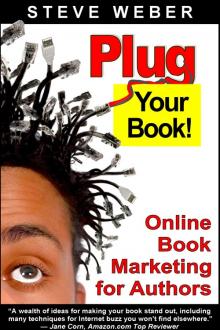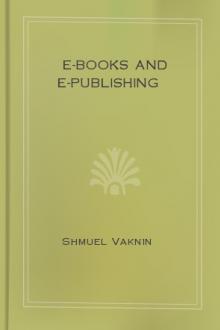Plug Your Book! by Steve Weber (books to read to be successful .txt) 📕

- Author: Steve Weber
- Performer: -
Book online «Plug Your Book! by Steve Weber (books to read to be successful .txt) 📕». Author Steve Weber
For the blogger, comments bring three key benefits:
Instant feedback on your ideas and writing, and a sense of what your audience finds valuable.
Feeling of participation and loyalty among your audience.
Adding valuable keyword density to your site, making it much more visible in search-engine results.
Like any tool, however, comments can be abused. It's not unusual to see rude or off-topic comments on some blogs, and even "spam comments" written solely to plant links back to the spammer's site. The worst spammers even use software robots, which scour the Web for target blogs and insert their junk links. Spam comments are usually along the lines of, "Hey, great blog. Come see us at #www.Cheap-Viagra.com#."
Fortunately, most problem comments can be prevented by using countermeasures like _ comment moderation_: you review and approve new comments before they appear on your blog. Another option is to allow readers to post comments immediately, and you review them later. The advantage is your readers get immediate gratification in seeing their comments posted as they submit them.
Most spam comments can be prevented by using word verification, requiring comment writers to type a short series of characters displayed in an image. This stops spam comments from software robots.
To be sure, some popular authors don't allow blog comments at all, such as marketing guru Seth Godin. Simply because they're well known, famous writers attract a certain number of crackpots and sycophants, and perhaps it's easier to avoid them by allowing no comments.
Blog style#Just as every book and author is unique, there's an endless variety of blog styles and flavors. All the blogging services have page templates, allowing you to start with a basic design and add a few personal elements.
Don't get bogged down looking for the "perfect" design. You'll always be free to tweak your design later, or do a complete overhaul. The most important thing is to get started adding content and building your audience.
The main design requirement is readability. Plain vanilla blogs are fine, and are actually preferred by most readers--it's the words that count. Black text on a white background might seem uninspired, but it's much easier on the eyes than white text on a black background or some other color. A plain masthead, simply your blog title in capital letters, is fine to start. The important thing is to get started.
Your blog's angleA nonfiction author's blog can approach the topic from several directions:
New developments.
New products or services.
Hot-button issues of the day.
What other blogs or media are saying.
Reviews of new books in the field.
You can publish a blog in the style of a perpetual newsletter, an aggregation of interesting tidbits about your book's topic. As you notice new things and write about them, each post is stacked on top, and with each new post added on top, one of the older posts is bumped from the bottom and sent to your archives.
Let's imagine you're writing a blog on the topic of Organic Strawberries. Your blog could serve as an information clearinghouse covering every conceivable angle and trend of organic strawberry growing, cooking and consuming. You'll constantly monitor consumer and trade media for the latest news on organic growing, interpret this material for your audience, and link to the source material, adding your own commentary.
Your blog could include:
Questions from your blog readers on organic fruit, along with your answers.
Guest articles from experts on organic strawberry gardening.
New books and magazines on the topic.
Strawberry dessert recipes.
The best places to grow organic strawberries.
Listings and maps of markets offering organic strawberries.
Reviews of cookbooks addressing natural, organic, fruit and dessert preparation.
Fiction authors have even more freedom, but a bigger creative burden. They can write about themselves, or even from the point of view of a fictional character. A story from their book can continue on the blog, veering off in new directions, experimentally, in response to suggestions from readers and other writers.
Raw materials for postsA free, easy way to find new raw material for your blog is to create a _ Google Alert_, which will automatically scour thousands of media sources for any keywords you specify. You'll be alerted via e-mail when something containing your keywords appears in newspapers, magazines, Web sites, or other sources. Sign up at:
#www.Google.com/alerts#
Google Alerts are also a handy way to monitor mentions of your blog title, book titles, and even your name or the names of other authors.
Your blog's titleA blog title usually spans the top portion of each page like a newspaper masthead. Titles are usually short and catchy--perhaps just a couple of nonsense words like Boing Boing, or a made-up compound word like RocketBoom or BuzzMachine. The name could be a non sequitur or double-entendre like PostSecret. Sometimes a title is just a title, like The Official Google Weblog.
Try to include in your title the most critical keyword related to your niche. _ Joe's Organic Strawberry Growing, Baking and Eating Guide_ is a good title. A poor title would be _Joe's Thoughts and Ideas about Fruit _ because nobody would search for something like that, and if they saw it, they couldn't guess what it's about. Be obvious. Pick a few words that will be easy for people to remember and to repeat in conversation and e-mails. #Writing your blog posts#
The essential ingredient of a blog is its short entries, or posts. They're arranged in reverse chronological order, with the newest at top. Posts can be a few sentences long, or many paragraphs long, and often link to outside information like blogs, newspaper stories, or multimedia clips hosted elsewhere on the Web.
Nearly any tidbit of information relevant to your audience can be spun into a blog post of some type:
Informational. # A news-oriented blurb. A new development. Question/Answer.# Easy to write, and fun to read. Reliable material, even if you have to make up the question. Instructional.# Can be a longer post, a tutorial that explains how to do something related to your niche. Link posts.# Find an interesting blog post elsewhere. Link to it and add your own spin. Rant. # Let off some steam, and let it rip. Interesting blogs don't play it safe, they take sides.Most blogs are conversational and informal, but that doesn't give authors a license to be sloppy. Readers expect clear writing from an author, and that requires attention to detail--not to mention beginning your sentences with capital letters and ending them with periods. It's worth proofreading and spell-checking your posts before publishing. Keeping your paragraphs short will minimize your rewriting chores.
Blogging categories#One helpful feature for you and your readers is blog categories. Assign each post to one or more categories, such as "technology," "marketing," "features," "reviews," or however you can best divide your material. Category headings can be listed on your blog's margin, and are especially valuable for new readers.
Assigning your posts to category headings can be especially handy later for your own writing tasks--you'll have material already divided into chapter topics.
Over the long haulBlogs evolve, and priorities change. It's impossible to draw up a road map for the future, but here are some strategic ideas to help give your blog long-term direction:
Write an anchor post every month or two. # An anchor post is a tutorial-style piece that teaches your readers how to do something, like How to Pick Fruit at its Peak of Flavor or Top 10 Ways to Prevent Identity Theft. It can be the length of a short magazine article, perhaps 750 to 1,500 words. This type of content is evergreen--it won't become obsolete, and you can continually refer back to it in your subsequent posts. Every month or two, add another anchor post. Write at least one new post a day. #Frequent posting keeps your audience interested and jogs your creativity. The more you post, the more you'll be picked up by the search engines, and the more new people will find your blog, become regular readers and buy your book. The first two sentences are the hardest of a post, and it's all downhill after that. Comment on other blogs in your niche. #This will attract fellow bloggers and their readers who follow the link in your comment back to your blog. Make a meaningful comment that advances the discussion, don't just say "I agree." Link to other blogs from within your blog posts. #With certain blogging software, this is known as a trackback, and leaves a summary of your blog post on the original blog. Result: More bloggers and readers find you. Ask for comments on your blog.# End your posts with a question, prompting your readers for feedback. When practical, end your posts with a question like, "What do you think?", or "What's your take on this?" Readers are often more interested in what _they _ have to say than in what _you _ have to say. Don't write when you're angry.# If you're upset, cool off for a few hours--or a day--before posting something nasty that you might regret later. It's nearly impossible to delete stuff on the Web. You might erase something from your blog, but the text can be archived in dozens of other places. Link to your old content.# After you've been blogging for a while, you'll have five or six previous blog posts that were most popular with readers--drawing lots of links, traffic and comments. For the benefit of new readers, link to these previous posts when you write about the same topics in the future. Add a small menu of these posts on the sidebar of your blog, with a heading such as #Lively Conversations# or #Greatest Hits#. Add artwork. # Sprinkling stock photos and illustrations in your blog posts is a simple way to add visual appeal. Images are eyeball magnets. Writing a post about how to fix a flat tire? Include a small stock photo of someone installing a tire. The site #www.sxc.hu# has thousands of royalty-free photos you can search by keyword. You needn't illustrate your posts literally, which can get boring. Let's imagine your post concerns some type of manipulation. It's the key idea and the main word in your post title. How could you illustrate it? Just search for "manipulation" at the photo site mentioned above, and you'll see dozens of images you could use as a smart illustration--like photos of puppets, marionettes or chess pawns. If your first keyword doesn't




Comments (0)